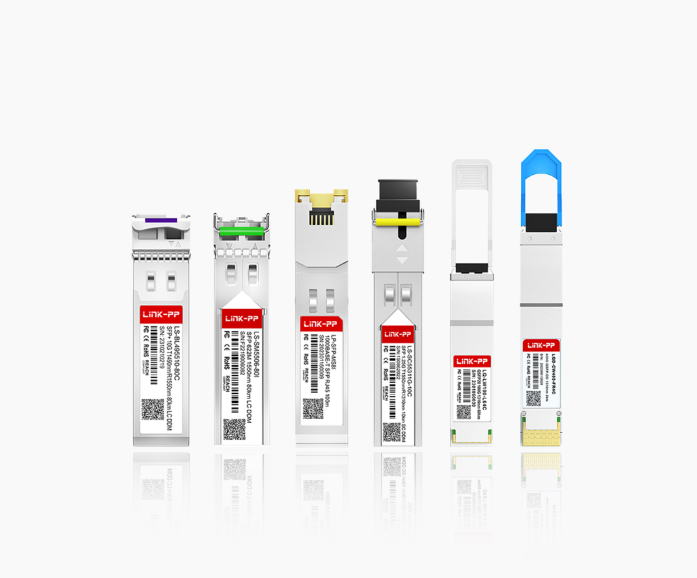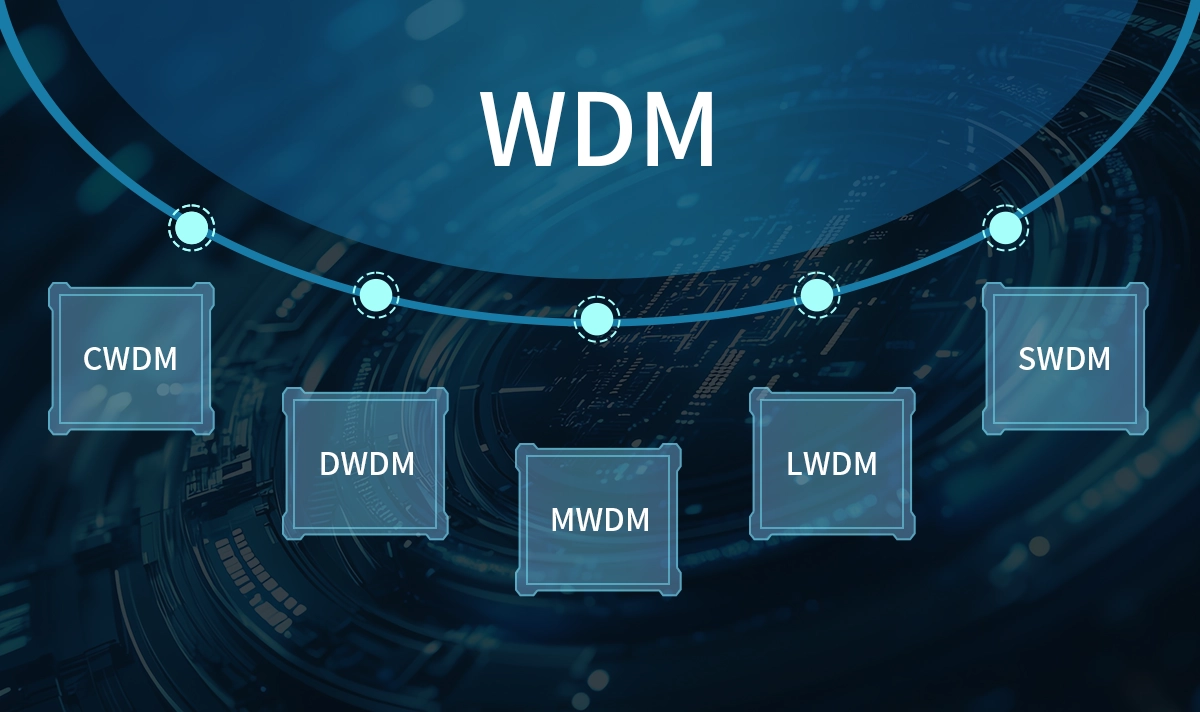
In the relentless pursuit of higher bandwidth and more efficient fiber utilization, wavelength division multiplexing (WDM) technologies are fundamental. But navigating the alphabet soup of CWDM, DWDM, MWDM, LWDM, and SWDM can be daunting. Each offers distinct advantages tailored to specific network needs and budgets. As a professional optical engineer, let's demystify these technologies and guide you towards the optimal optical transceiver solution, including high-performance options from LINK-PP.
By comparing CWDM vs DWDM vs MWDM vs LWDM vs SWDM, you can make an informed decision to ensure your network meets your data capacity, distance, and application requirements. Choosing the right wavelength division multiplexing technology guarantees optimal network performance tailored to your needs.
▶ Understanding the Core Principle: Wavelength Division Multiplexing (WDM)
WDM boosts fiber capacity by transmitting multiple optical signals simultaneously on a single fiber strand. Each signal travels on its own unique wavelength (or color) of light, effectively creating parallel lanes of data. The differences lie in channel spacing, wavelength range, capacity, reach, and cost.
1. Coarse Wavelength Division Multiplexing (CWDM)

Channel Spacing: 20nm
Common Channels: 18 channels (1270nm to 1610nm)
Key Features: Uses uncooled lasers, significantly lower cost per channel, simpler design, lower power consumption.
Applications: Short to medium reach (up to 80km), cost-sensitive metro access, enterprise networks, point-to-point links.
Pros: Very cost-effective, low power, simple deployment.
Cons: Limited channel count, shorter reach due to uncooled lasers, wider spacing limits capacity density.
LINK-PP Solution: Our CWDM SFP, SFP+, QSFP+, and QSFP28 optical transceivers (e.g., LS-CW4710-20C) provide reliable, budget-friendly connectivity for access and aggregation layers.
2. Dense Wavelength Division Multiplexing (DWDM)
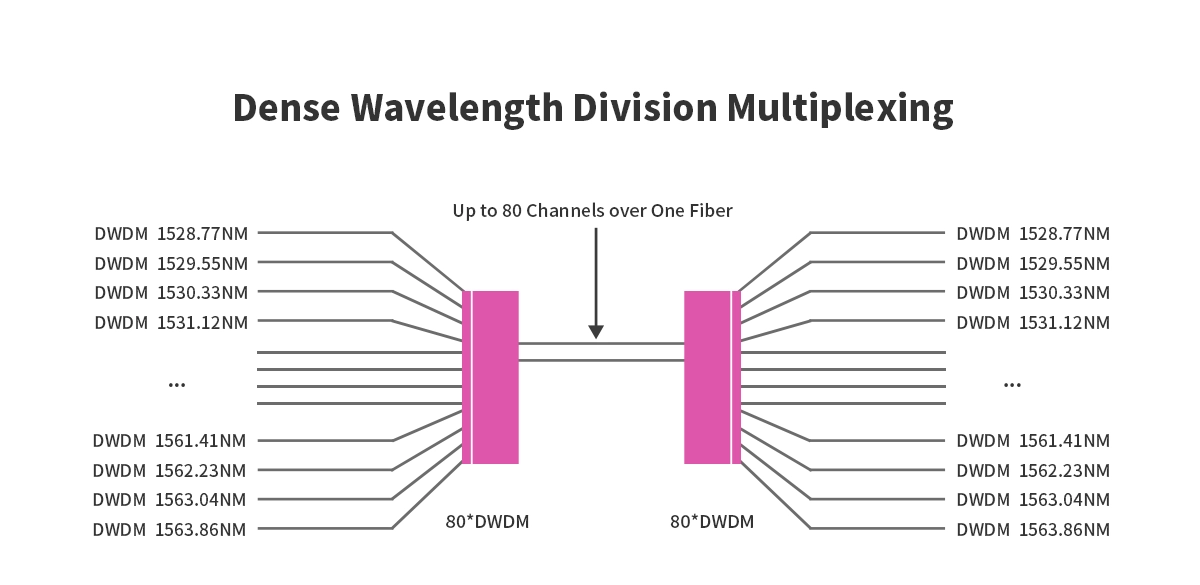
Channel Spacing: 0.8nm (100GHz) or 0.4nm (50GHz) or 0.2nm (25GHz)
Wavelength Range: C-band (1525nm - 1565nm) primarily, sometimes L-band (1570nm - 1610nm)
Key Features: Uses temperature-stabilized cooled lasers for precise wavelength control, enabling high channel counts and long reach. Supports advanced modulation formats and amplification (EDFA).
Applications: Long-haul networks, high-capacity metro/core networks, submarine cables, data center interconnect (DCI).
Pros: Highest capacity potential (96+ channels), longest reach (80km+), compatible with optical amplification.
Cons: Highest cost per channel, higher power consumption, more complex system management.
LINK-PP Solution: Explore our extensive range of LINK-PP DWDM SFP+, QSFP28, QSFP-DD, and OSFP optical transceivers (e.g., LS-DW2610-40I) for scalable, high-performance long-haul and DCI solutions.
3. Medium Wavelength Division Multiplexing (MWDM)
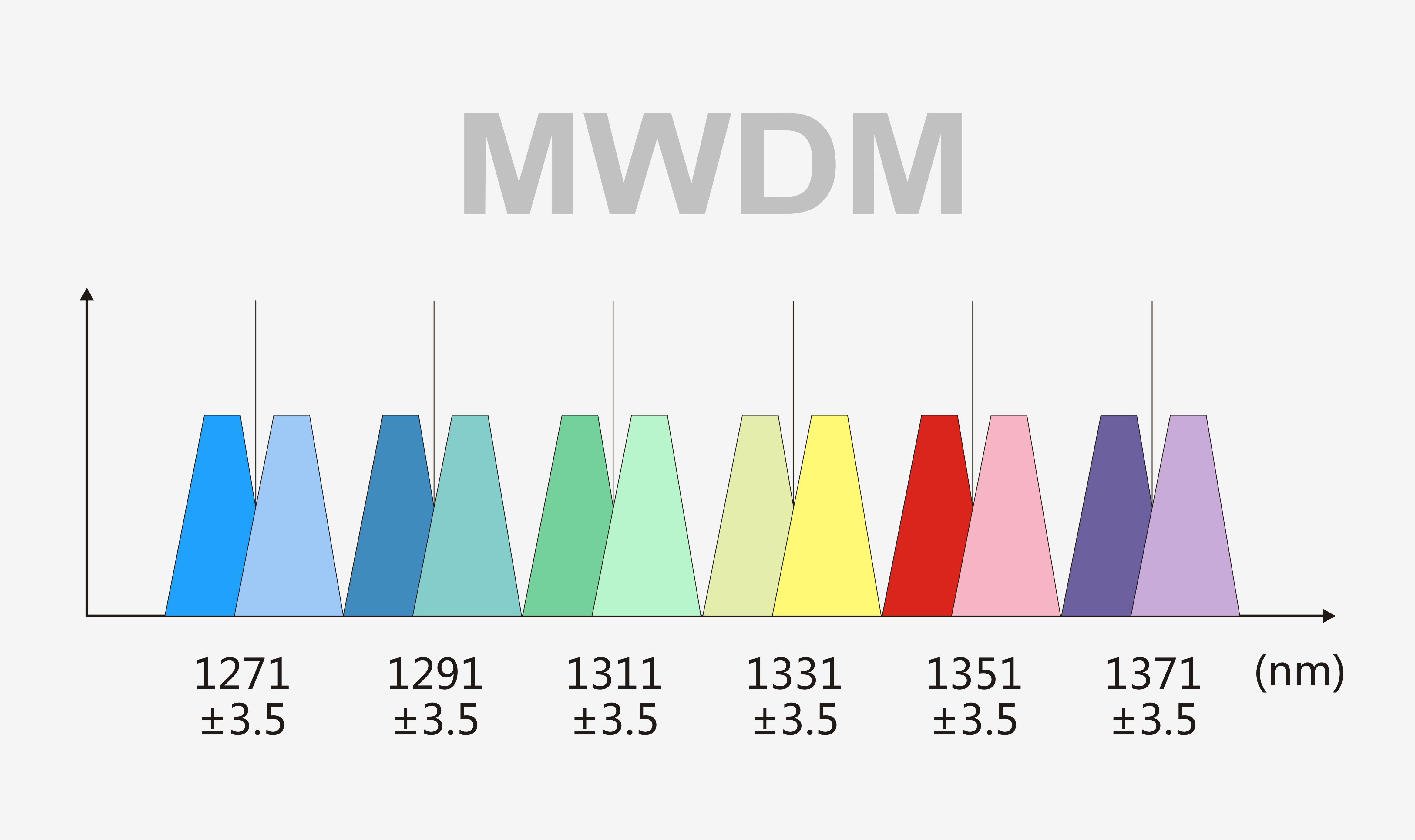
Channel Spacing: 7nm (semi-active tuning)
Key Features: Evolved from CWDM for 5G fronthaul. Uses 12 wavelengths derived by shifting 6 traditional CWDM wavelengths left and right (±3.5nm) using temperature tuning. Balances cost and channel density.
Applications: Primarily 5G mobile fronthaul and midhaul networks requiring moderate capacity and cost efficiency.
Pros: Higher density than CWDM (12 vs 8 usable channels in common bands), more cost-effective than full DWDM for medium reach.
Cons: More complex than CWDM, shorter reach than DWDM, limited primarily to 5G fronthaul use cases.
LINK-PP Solution: LINK-PP MWDM SFP28 and QSFP28 optical modules deliver the optimized price/performance needed for scalable 5G infrastructure.
4. LAN (or Local Area Network) Wavelength Division Multiplexing (LWDM)
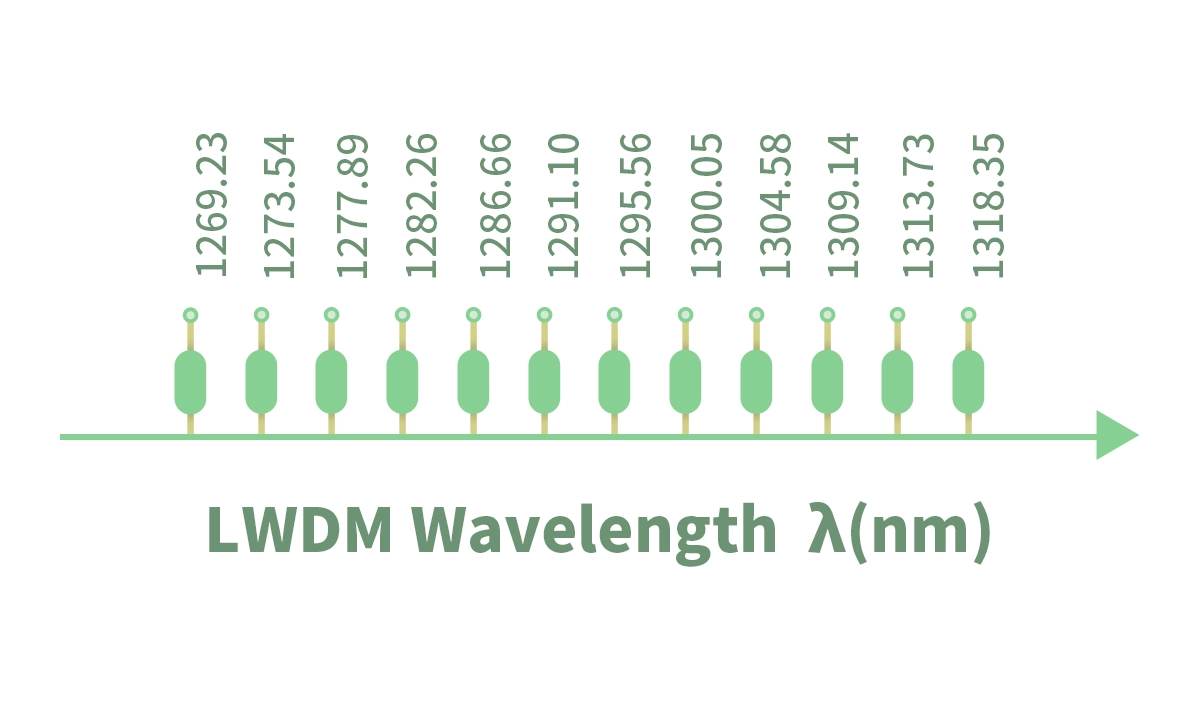
Channel Spacing: 4nm
Wavelength Range: Centered around the 1310nm O-band (1269nm - 1332nm for 12 channels).
Key Features: Targets cost-effective multi-wavelength solutions within the low-dispersion O-band. Uses DML lasers with moderate temperature control.
Applications: Enterprise data centers, campus networks, short-reach DCI (up to 10km), aggregation requiring more channels than CWDM within a rack or building.
Pros: Good channel density for O-band, lower chromatic dispersion than C-band over shorter distances, more cost-effective than DWDM for specific short-reach scenarios.
Cons: Limited reach compared to DWDM, specific wavelength band focus, less mature ecosystem than CWDM/DWDM.
LINK-PP Solution: LINK-PP LWDM QSFP28 optical transceivers (e.g., LS-LW100-ER4C) offer efficient multi-lane connectivity for intra-data center and campus links.
5. Short Wavelength Division Multiplexing (SWDM)

Technology: Multiplexes multiple short wavelengths (typically 850nm, 880nm, 910nm, 940nm) onto a single multimode fiber strand using VCSELs.
Key Features: Designed specifically to extend the capacity and reach of legacy OM3/OM4 multimode fiber. Uses parallel optics principles but over a single fiber pair.
Applications: High-speed connections within data centers over existing multimode fiber (MMF) infrastructure, especially for distances beyond standard parallel optics.
Pros: Maximizes use of installed MMF, cost-effective upgrade path, simpler fiber management than single-mode solutions for short reach.
Cons: Limited to MMF, shorter reach than single-mode solutions (up to 150m on OM5 for 100G), specific wavelength band.
LINK-PP Solution: Leverage your MMF with LINK-PP SWDM QSFP28 optical modules (e.g., LS-SW100-SR4C) for efficient 100G connectivity in the data center.
CWDM vs DWDM vs MWDM vs LWDM vs SWDM: Technology Comparison at a Glance
Feature | CWDM | DWDM | MWDM | LWDM | SWDM |
|---|---|---|---|---|---|
Primary Use | Cost-Sensitive Access | High-Capacity Long Haul/Core | 5G Fronthaul/Midhaul | Short-Reach Multi-Channel (O-band) | MMF Capacity Extension |
Channel Spacing | 20nm | 0.8nm / 0.4nm / 0.2nm | 7nm (semi-active) | 4nm | N/A (Discrete Wavelengths) |
Typical Channels | Up to 18 | 40, 80, 96+ | 12 | 12 (O-band) | 4 (850-940nm range) |
Laser Type | Uncooled DFB | Cooled DFB/EML | Tuned DML | Tuned DML | VCSEL |
Fiber Type | Single-Mode | Single-Mode | Single-Mode | Single-Mode | Multimode (OM3/OM4) |
Typical Reach | Up to 80km | 80km+ | 10-20km | Up to 40km | Up to 150m (OM4/100G) |
Relative Cost | Lowest | Highest | Medium | Medium | Medium (Leverages MMF) |
Key Advantage | Simplicity, Low Cost | Massive Capacity, Long Reach | Cost/Density Balance for 5G | Density/Cost in O-band | Uses Existing MMF |
▶ Choosing the Right Technology: Key Considerations
Selecting the optimal optical transceiver technology hinges on your specific requirements:
Required Capacity & Scalability: How much bandwidth do you need now? How much might you need in 3-5 years? DWDM offers the highest scalability.
Reach: Are you connecting within a building, across a campus, a metro area, or between cities? SWDM suits short reach; CWDM/MWDM/LWDM for medium; DWDM for long.
Existing Fiber Infrastructure: Do you have single-mode or multimode fiber? Is fiber count limited? SWDM maximizes MMF; DWDM/CWDM maximize SMF strands.
Budget Constraints: What are your CAPEX and OPEX limitations? CWDM and SWDM often offer the lowest entry cost.
Application: Is this for 5G fronthaul (MWDM), enterprise LAN (LWDM/CWDM), data center (SWDM/LWDM/DWDM), or long-haul transport (DWDM)?
▶ Why Partner with LINK-PP for Your Optical Transceiver Needs?

Navigating the complexities of WDM technologies and sourcing reliable optical modules is critical for network performance and uptime. LINK-PP stands out by providing:
Comprehensive Portfolio: Industry-leading range of CWDM, DWDM, MWDM, LWDM, and SWDM optical transceivers (SFP, SFP+, SFP28, QSFP+, QSFP28, QSFP-DD, OSFP).
Superior Quality & Compatibility: Rigorously tested modules ensuring seamless interoperability with major OEM switches and routers.
Cost-Effective Solutions: Delivering high performance without the premium price tag, offering significant savings.
Expert Technical Support: Our engineering team provides deep expertise in wavelength division multiplexing design and deployment.
Ready to explore high-quality, reliable optical transceivers for your specific WDM application?
▶ FAQ
What is the main reason to choose CWDM over DWDM?
You should pick CWDM if you want a simple and cost-effective solution for short or medium distances. CWDM uses fewer channels and does not need expensive equipment. It works well for metro or access networks.
Can you mix different WDM types in one network?
You can combine some WDM types, but you must check compatibility. For example, you can use CWDM and DWDM together with special filters. Always ask your equipment provider before mixing technologies.
How do you decide which WDM technology fits your needs?
Check your network distance.
Count how many channels you need.
Set your budget.
Think about future growth.
Pick the technology that matches these needs best.
Does SWDM work with regular multimode fiber?
SWDM works best with OM4 or OM5 multimode fiber. You can use it with older OM3 fiber, but you may get shorter distances. Always check your fiber type before installing SWDM modules.
▶ See Also
Exploring WDM Technology And Its Uses In Optical Networks
The Importance Of Digital Monitoring In Optical Transceiver Devices




